Global carbon emissions may be on the rise and poised to reach an all-time high this year, but that doesn’t mean there isn’t positive climate news to talk about. If you are looking for some uplifting stories about the environment as we close out 2018 and head into the new year, here are six reasons to be hopeful in spite of climate change.
Plant-based meat
The carbon dioxide produced from burning fossil fuels is still the main greenhouse gas, but methane and nitrous oxide are more potent, and the levels are rising. Livestock farming is the main source of methane and nitrous oxide, and because the world loves meat and dairy, these gases are a huge factor in the battle against climate change. Simply put, if we don’t radically curb our meat consumption, we can’t beat global warming.
Related: Look out meat industry — flexitarianism is on the rise
People all over the world are switching to vegetarian, vegan and flexitarian diets, and that is a step in the right direction. Bill Gates has invested in two plant-based burger companies that make food from plants that looks and tastes like meat. Major companies like Tyson, Danone and Nestle are also investing in plant-based products that have a tiny carbon footprint, so the market will continue to grow and offer a wide variety of plant-based foods.
The renewable energy revolution
Renewable energy is quickly becoming the new normal. Thanks to the cost of solar panels and wind turbines plummeting over the last decade, renewables are now cheaper than coal. There are already systems in place to shift from gas and oil to renewables.
Companies all over the world are committing to renewable energy, and now more than half of the new capacity for generating electricity is renewable.
Many parts of the world are already installing the cheapest electricity available. Last year, there was so much wind power in Germany that customers got free electricity.
Even in the U.S., despite President Trump’s rollback of key climate legislation, there has been $30 billion invested in renewable energy sources.
“We Are Still In” movement
As a response to President Trump’s decision to back out of the Paris Agreement, thousands of America’s CEOs, college presidents and politicians have declared that the U.S. is “still in” the climate change fight with the We Are Still In movement.
Over 2,600 leaders from across the country are standing together and committed to delivering the goals from the Paris Agreement. They also want to make sure that the U.S. continues to be a world leader in reducing emissions. More than 1,800 businesses and investors, 18 states and tribes and 335 of America’s colleges and universities are also part of the movement. More than half of the country’s Fortune 500 companies have the goal of cutting pollution.
The death of coal
Production of fossil fuels seems to have peaked in 2013, and since then, the demise has been shocking. Five years ago, the IEA anticipated a 40 percent growth in coal burning by 2040. But now, it only expects 1 percent growth.
Bankruptcies are taking over the coal industry, and plans for many new coal plants are now dead and buried. China has halted plans for 151 coal plants, and in the U.K., coal has plummeted from 40 percent of the power supply to just 2 percent.
This is all happening because solar and wind are now cheaper, but there is still more that can be done. When it becomes cheaper to build renewable energy sources compared to running existing coal plants, there will be zero reasons to keep digging coal out of the ground.
Electric cars
Oil is responsible for providing one-third of the world’s energy, so figuring out how to reduce this usage is a big challenge. One of the most promising options for reducing oil usage is battery-powered cars. They are starting to make a dent in the market, and China is leading the way by selling more electric cars every month than the U.S. and Europe combined.
Just about every car manufacturer has plans to go electric, and some will be doing it sooner rather than later. Both Volvo and Jaguar Land Rover have announced plans to end production of pure fossil-fueled cars by 2021, and Tesla has already rolled out its Model 3.
If current growth rates continue, EV-volumes.com analyst Viktor Irle said that 80 percent of new cars will be electric by 2030.
Batteries
A big piece of the renewable puzzle is batteries. The big issue is how to deliver solar power when it’s cloudy or how to provide wind power on a calm day. New battery technology is now making it possible to continuously store renewable power, even when the sun is behind the clouds and the wind stops blowing.
With battery technology improving so fast, the price of battery storage is expected to drop in half by 2030. The price of lithium-ion batteries has already dropped by 75 percent over the last six years. The latest battery technology is also contributing to the rising demand for electric cars.
Via Grist, The Guardian and WWF
Images via Appolinary Kalashnikova, KMW737, Andreas160578, Jon Tyson, Benita Welter, Stefan Schweihofer and Sabine van Erp
Source: INHABITAT















